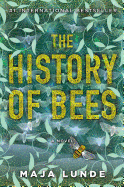
The History of Bees offers a warning to readers: protect the earth's bees, or there could be drastic consequences in the future. Though the dystopian future Maja Lunde has imagined--a world of limited food resources and collapsing economies--is fictional, the possibilities she has imagined due to the death of bees are based on science. Lunde writes with great historical detail about beekeeping, beekeepers' histories and the development of scientific research. These realities serve to bring Lunde's lush story to life as the novel moves among three interconnected stories. Tao and Kuan, parents to three-year-old Wei-Wen in 2098 China, do the one-time work of the now deceased bees, manually pollinating flowers. William Savage, natural scientist hopeful and failing shopkeeper in 1851 England, aims to make his mark on the world by designing a new tool for the study of bees. And George, a United States beekeeper and farmer in 2007, faces the decimation of his stock of bees as the decline of bee populations across the world threaten the sustainability of food production.
The History of Bees feels fractured at times. Short chapters with frequent jumps between characters and time periods make it hard to grasp the novel's depth at first, and harder still to become invested in any one character's story. But as the three stories move together, Lunde's novel proves a powerful cautionary tale about the human condition, scientific inquiry and the importance of bees in sustaining our ecosystems--and what happens when all three collide. Readers interested in sustainability or realistic dystopias will find much to enjoy in Lunde's first novel for adults. --Kerry McHugh, blogger at Entomology of a Bookworm

